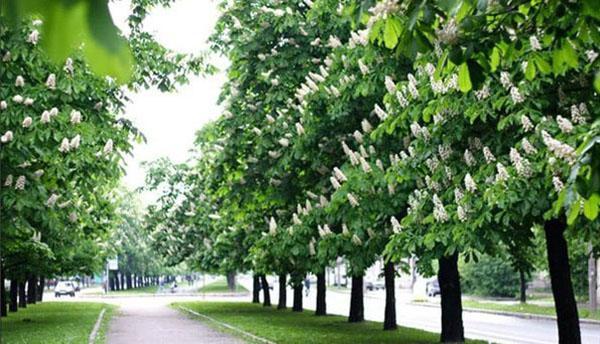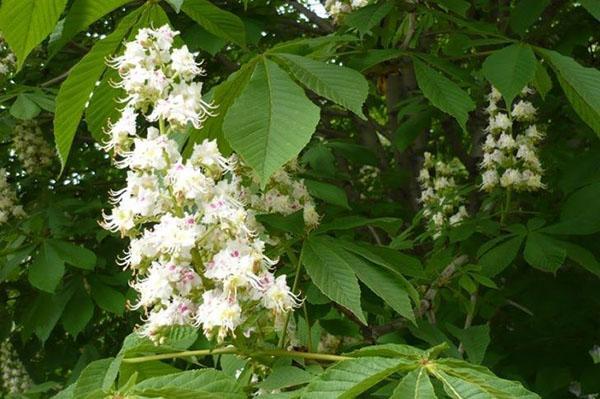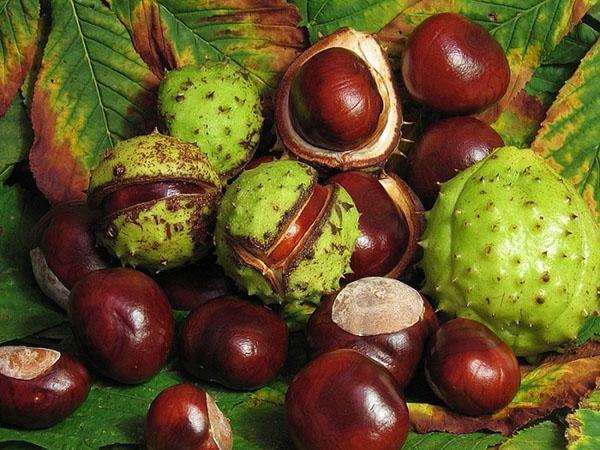We decorate the summer cottage with an amazing horse chestnut
 Decoration of city streets and parks - horse chestnut, can be seen in many regions of the middle lane. The tree is widely used in landscaping, as it is highly decorative throughout the warm season. In summer it gives a thick shadow, in spring it blooms brightly and unforgettably, in autumn it pleases with an abundance of decorative fruits. The leaves of this tree are depicted on the symbols of cities in many countries. It is especially popular in Germany, the Czech Republic and Ukraine.
Decoration of city streets and parks - horse chestnut, can be seen in many regions of the middle lane. The tree is widely used in landscaping, as it is highly decorative throughout the warm season. In summer it gives a thick shadow, in spring it blooms brightly and unforgettably, in autumn it pleases with an abundance of decorative fruits. The leaves of this tree are depicted on the symbols of cities in many countries. It is especially popular in Germany, the Czech Republic and Ukraine.
Description of the chestnut tree

Chestnut tree - description:
- light-loving;
- the crown is domed, spreading;
- the trunk is correct cylindrical;
- pivotal root system;
- leaves are opposite with 5-7 ovate leaflets 15-30 cm long;
- inflorescence panicle with white speckled flowers, 20-40 pieces;
- fruit box with 1 nut inside.
It blooms in May, first leaves open, then flowers appear. After the end of the flowering period, and it lasts 2 weeks, 1-3 fruits are formed on each brush. The capsules are green at first, covered with thorns. By autumn, they acquire a brown color, crack and show a nut. Small smooth brown chestnuts reach 3-4 cm in length. They are the main means of plant propagation in natural conditions of nursery willows. The harvest ripens in August-September.
During the flowering period, the plant is a good honey plant.
The homeland of the plant is Greece. In the wild, it can be found in Macedonia, Albania, Bulgaria, Serbia, in the foothills of the Himalayas, climbing to an altitude of 1000 m above sea level. It can grow in the steppe - due to its strong root, it is not afraid of the gusty steppe wind. Where else does chestnut grow? In nature, it coexists with ash, beech, alder and other deciduous tree species. Cultivated in most of the CIS countries. In the Moscow region, young trees often freeze slightly, as in St. Petersburg. There are especially many chestnuts in Kiev.
Read on:how to fry chestnuts in a pan?
How to sprout a nut
 Chestnut is a large-sized one with a developed root system. It is grown on large tracts of land, where there is a lot of light and there are no residential buildings nearby. How to grow chestnuts from walnuts for landscaping a site? The main requirement for successful cultivation is seed stratification before planting.
Chestnut is a large-sized one with a developed root system. It is grown on large tracts of land, where there is a lot of light and there are no residential buildings nearby. How to grow chestnuts from walnuts for landscaping a site? The main requirement for successful cultivation is seed stratification before planting.
The larger the fruit, the higher the likelihood of a strong seedling.
Stratification can be natural or artificial. The chestnut fruit has a thick peel that reliably protects the sprout inside. That is why he is not afraid of frost and bad weather. But it is the low air temperatures that awaken the sprout to life for a long period of time. In natural conditions, stratification occurs during the winter months on the ground, under a layer of fallen leaves.
To carry out stratification in artificial conditions, you need:
- choose the largest specimens of nut-like fruits;
- pour a layer of river sand into a wooden box;
- put the fruits at a distance of 15 cm from each other;
- pour another layer of sand on top of at least 15 cm;
- put in a cellar or basement until spring.
If you need a lot of planting material, take a high box and lay several layers of seeds, alternating with layers of sand.
How to germinate chestnuts in artificial conditions? In March-April, depending on weather conditions, a box with seeds is taken out of the basement and placed in a warm room, after moistening the soil. The box should stay warm for about 2-3 weeks. After that, the nuts are removed from the sand and soaked in warm water for 4-6 days. During this time, the fruit will swell and it will be easier for the sprouts to appear outward. The water in the tank is changed every day.
If the weather outside is cold and the spring is prolonged, the chestnuts can be planted in small containers with fertile soil to a depth of 5-7 cm and watered well.
For successful germination, the air temperature should not fall below 7 ° C.
Horse chestnuts reproduce well in natural conditions. You can easily get strong planting material if you look for overwintered and hatched nuts right under an adult tree. They are transferred to the desired area and planted in a temporary or permanent place.
Growing features
 The tree grows quickly if it is provided with favorable conditions. How to plant chestnuts correctly? To begin with, the site for planting is cleared of weeds. It should be 50 by 50 cm square. The plant does not like acidic, saline or waterlogged soils, therefore, the planting site is chosen with sandy or chernozem soils, where the groundwater does not lie closer than 1 m to the earth's surface.
The tree grows quickly if it is provided with favorable conditions. How to plant chestnuts correctly? To begin with, the site for planting is cleared of weeds. It should be 50 by 50 cm square. The plant does not like acidic, saline or waterlogged soils, therefore, the planting site is chosen with sandy or chernozem soils, where the groundwater does not lie closer than 1 m to the earth's surface.
Sprouted nuts are planted in May, when the threat of return frosts has passed. The fruit is buried by 5-7 cm, sprinkled with soil and moistened, followed by loosening. Be sure to put a mark next to it. In dry weather on sandy soils, regular watering of young seedlings is necessary throughout the dry season.
Over the summer, the seedling grows up to 50-60 cm. Above in the photo is a horse chestnut in the first season after planting. The tree is unpretentious in cultivation, but in the first few years in severe winters, cover with non-woven material is needed. Sprinkle the trunk circle peat or fallen leaves, and the crown is wrapped in a spunbond type material, but only if severe frosts are likely to occur, this is not necessary to do in advance.
 If the area where the tree is planted is really large, and the branched root system will not inhibit the growth of other plants, it is shortened. This is done on young seedlings by partially cutting off the main taproot. This gives an incentive to develop lateral shoots, which increases the tree's resistance to strong winds and improves its nutrition.
If the area where the tree is planted is really large, and the branched root system will not inhibit the growth of other plants, it is shortened. This is done on young seedlings by partially cutting off the main taproot. This gives an incentive to develop lateral shoots, which increases the tree's resistance to strong winds and improves its nutrition.
From this procedure, the crown also becomes thicker and more decorative. In hot regions, where there is a high probability of prolonged heat with air temperatures of 30 ° C, seedlings are planted in partial shade to avoid burning the leaves. Burnt leaves turn brown and dry out, significantly reducing the decorative effect of the plant.
Horse chestnut is good because it is almost not damaged by insects and diseases. For several years it grows into a full-fledged tree, the crown of which gives the desired shade in the summer heat. When grown far from the city, the fruits, flowers and bark can be used for medicinal purposes.
The use of horse chestnut in landscape design
 In urban landscaping, chestnut is used much more often than in the backyard. Trees are formed into even shady alleys in parks or planted in single specimens in combination with other deciduous or coniferous species. You can clearly see in the photo how the chestnut tree blooms and how decorative it is during this period.
In urban landscaping, chestnut is used much more often than in the backyard. Trees are formed into even shady alleys in parks or planted in single specimens in combination with other deciduous or coniferous species. You can clearly see in the photo how the chestnut tree blooms and how decorative it is during this period.

The plant belongs to long-lived, in natural conditions lives up to 300 years, therefore it is so often used in landscaping. Today, there are many varieties of the common horse chestnut. Specimens with a drooping crown look especially decorative. There are subspecies in the form of a bush, reaching only 2 meters in height, there are dwarf trees and standard forms.All of them fit perfectly into landscapes of different types, from rustic gardens to elegant English and French.